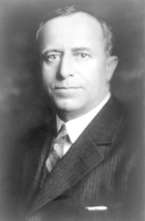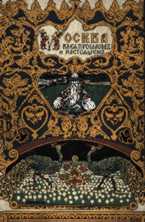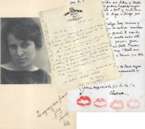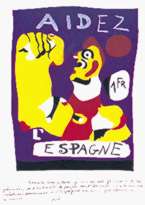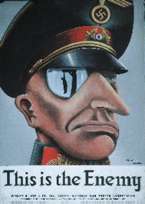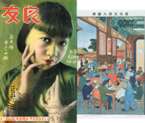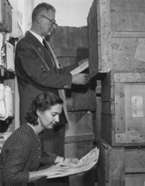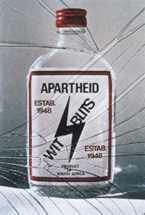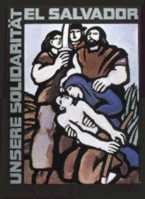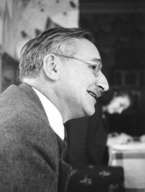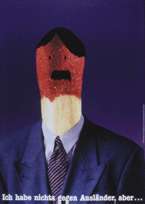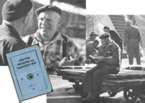- History
- World
Herbert Hoover loved books. An avid collector before World War I, he specialized in rare tomes about mining. The idea of collecting twentieth-century history, however, came to him during the first winter of the war as he made one of his many English Channel crossings as head of the Commission for Relief in Belgium. He had read an autobiography of Andrew D. White, historian and first president of Cornell, who described the French historical collection he had amassed, including not just books but fugitive materials, that is, materials that easily deteriorate and disappear, such as manuscripts, pamphlets, posters, and reports. Hoover realized that he was in a unique position to do the same for the cataclysm that was currently engulfing Europe, thereby helping scholars understand the causes and consequences of the Great War.
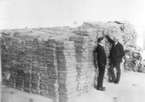 |
| FIRST SHIPMENT. Ralph H. Lutz (left) and Ephraim D. Adams, codirectors of the fledgling Hoover War Library, inspect the first arrival of materials.
|
After the war, Hoover sent a cable dated April 23, 1919, saying, "advise Wilbur, Adams that if they keep it entirely confidential we can find cost of their sending at once suitable mission to Europe to collect historical material on war providing it does not exceed fifty thousand without further consideration." Hoover clarified, "My idea is simply to collect library material on the war generally." History professor E. D. Adams wasted no time. A week later he and his wife were on the boat to Europe.
Hoover told Adams that he was interested not in the war's military aspect but in its socioeconomic causes and effects as well as the issue of food administration. He put the structure of his postwar food relief organization, the American Relief Administration (ARA), at Adams's disposal. In addition, he enabled two of Adams's former students to be released from their army duty. Private Robert C. Binkley ('22) and Lieutenant Ralph Lutz ('06), the latter a professor at the University of Washington, became officially attached to the ARA; actually both were out collecting documents.
Adams stayed in Paris to collect the propaganda produced by delegates to the Paris Peace Conference, while Lutz traveled throughout Eastern and Central Europe, setting up a network of contacts, including book dealers, libraries, and government personnel. A successful ploy when asking German government bureaucrats for materials was to pull out a large list of promised French materials, motivating the Germans to exceed the French in all departments.
Stanford professor Frank Golder joined Lutz, and together they laid the foundations for the Eastern European and Russian collections, which are among Hoover's most distinguished collections. One of Golder's important contacts was Anatoli Lunacharskii, the Soviet commissar for education, from whom Golder received copies of government directives.
After the first $50,000 ran out, Hoover continued to finance the collecting with large grants. He felt that there would be "a thousand years to catalogue this library, but only ten years in which to acquire the most valuable of material." Lutz, now director, accelerated his collecting to a frenzied pace. In 1933 the scope of the library was expanded from the documentation of the Great War to the problems of securing the peace and the ideological movements that grew out of the war, particularly communism and fascism. In 1938, a name change to the Hoover Library on War, Revolution and Peace reflected this broader scope.
Through the socialist Angelica Balabanoff, Lutz connected with Mathilde Jacob, secretary and friend of German communist Rosa Luxemburg, who was assassinated in 1919. Balabanoff gave Lutz a complex code and instructions on detours to avoid being followed to his meetings with Jacob. Jacob gave him all the papers that would fit in his briefcase, including more than one hundred letters from Luxemburg, as well as her prison calendar.
Having foreseen the coming of the Second World War, Lutz had instructed his network of dealers, collectors, and government officials to continue collecting but to hold off shipment until peacetime. Lutz established a Washington office to collect government documents and propaganda during the war and successfully lobbied Washington to establish a Civil Affairs Training School at Hoover. These trainees led the U.S. army of occupation after the war and often became dedicated collectors for Hoover.
As the collections grew, the space in the University Library became less than adequate, resulting in the construction of Hoover Tower, which opened in June 1941 in conjunction with the celebration of Stanford's fiftieth anniversary.
In 1943, as Lutz's health began to decline, ARA historian and curator Harold H. Fisher took over his duties.
Once the war was over, shipments began to flow to Hoover again, including those from Stanford students and professors who had become Hoover collectors as they fulfilled their military duties. Major Lee Telesco, who led a Filipino guerrilla force, sent back a complete set of the journals of the Japanese military government in the Philippines and other materials from the Japanese occupation. The alumni association in Tokyo took on the job of collecting Japanese materials, and an office was opened under Colonel (and Stanford professor) Hubert G. Schenk.
In addition, a Chinese collection began after the war, with Herbert Hoover himself locating documents during his food relief missions for President Truman in 1946. Although collecting was difficult in China because of the upheavals caused by civil war, a network of collectors having Stanford affiliations, such as historians Mary and Arthur Wright, combed the country for materials, traveling in anything available, from vegetable carts to military aircraft. This activity stopped in 1949 with the establishment of the People's Republic of China.
As the only repository of materials in Chinese and Japanese on the Stanford campus, Hoover's East Asian Library, directed by curator Ramon Myers, has developed broader subject areas—including religion, literature, and philosophy—than the rest of the collections. In addition, many texts predate the twentieth century, in some cases going back several hundred years.
 |
| A young Leon Trotsky stares out of an Okhrana mug book of wanted revolutionaries.
|
Witold Sworakowski, who arrived as a Slavic studies fellow in 1947, became assistant, then associate director of the Hoover Institution. His legendary ability to attract significant collections resulted in the papers of the emigré Russian diplomat Nicholas de Basily. Sworakowski's greatest collecting coup, however, was the acquisition of the Boris Nicolaevsky collection, which contains material on social revolutionary movements in Europe. Among the many treasures of the collection are three hundred letters between Leon Trotsky and his son, Lev Sedov, an original Friedrich Engels manuscript, and a letter from Vladimir Lenin.
The African collection began in the early 1920s, with Belgian government documents on the Congo and League of Nations mandate materials acquired by Hoover librarian Nina Almond, but it was the 1960s that marked the real flowering of the collection. As the South African government cracked down on black opposition movements, African curator Peter Duignan visited the country and established a network of agents. They filmed archives, files, and papers of opposition groups and collected ephemera and radical newspapers, from which a four-volume documentary history was published. Liberation ephemera was also collected from Angola, Mozambique, Guinea-Bissau, Namibia, and Zimbabwe. Lewis H. Gann's arrival in 1963 spurred collecting on African colonialism.
Although collecting in Latin America began with the Paris Peace Conference in 1919, and continued by special representatives during the ensuing years, the first curator for Latin America, Joseph W. Bingaman, was appointed in 1963. Although initially his mission was to document communism in the region, particularly in Cuba, by 1965, with the aid of a Ford Foundation grant, collecting was expanded to include general works on the issues of political, economic, and social change. The documentation on the presidency of Juan Perón and the Perónist movement has become the world's largest collection of papers and photographs on that subject accessible to the public.
The Middle East collection was officially established in 1948, although materials from the region had been collected from the beginning, as Turkey was a belligerent in the Great War. In the 1960s Hoover participated in the Library of Congress's PL 480 Program for the Middle East, which allowed funds in blocked currencies held by U.S. embassies to be used to acquire books and periodicals. The thousands of Arabic volumes and newspapers thus obtained were predominantly from Egypt; subjects ranged from philosophy and religion to classical Islamic texts and modern Arabic and Turkish literature. Today the collection's scope focuses on the history, economics, and politics of the twentieth century and U.S. national security interests in the region.
Since the 1970s a great expansion in collecting has brought in American papers, including those of military commanders General Albert C. Wedemeyer and Major General Edward C. Lansdale and Secretary of State George P. Shultz and other cabinet officials.
New acquisitions include the collections of many European intellectual emigrés from Nazi governments, key among them philosopher Karl Popper. Gleb Struve's papers, which describe his intellectual life as a Russian emigrant, became another jewel in the Russian collection. The Herman Axelbank film collection sheds new light on events in revolutionary and prerevolutionary Russia and the USSR. Hoover's documentation of Poland's Solidarity movement dates back to its founding in the early 1980s. In 1990, a major effort to document the transition from communism to democracy was accelerated when an office opened in Warsaw to facilitate collecting throughout Eastern Europe.
The various revolutions of 1989, velvet and otherwise, which overthrew communist regimes, were assiduously monitored and collected by Curators Maciej Siekierski and Joseph Dwyer, who returned with 2.6 tons of new material between 1991 and 1993. As latter-day Lutz and Golder, they continue to travel the region.
In 1991–92, after the collapse of the Soviet Union, Hoover deputy director Charles Palm, who administers the Hoover Library and Archives, and Rudolph G. Pikhoia, the chairman of the State Archival Service of Russia, concluded an agreement allowing Hoover to microfilm Soviet Communist Party documents, more than eleven million pages of documentation. The project continues into the new century with the filming of the records of the People's Commissariat of Internal Affairs that operated the vast networks of labor camps in the Gulag.
Deputy curator Karen Fung collects sub-Saharan African history from 1870 to the present, focusing on politics, economics, and social developments, including AIDS education and democratic movements.
In Asia, trends toward greater democracy in Taiwan and the return of Hong Kong to the People's Republic of China are among the subjects of collecting efforts. Deputy curator Edward Jajko acquires materials on the Islamic and opposition movements and other subjects in the Middle East. Curator William Ratliff collects material on the political and economic transformations in Latin America, interviewing many of the leading players. The development of a unified economic community in Western Europe and the politics of immigration, right-wing nationalism, and other current issues are collected by Senior Specialist Helen Solanum. Gerald Dorfman, the Hanna Education curator, continues to collect national and international educational materials from individuals, institutions, and organizations. Archivist Elena Danielson, who has oversight responsibilities for the Hoover Archives, nurtures relationships with potential donors with letters and personal visits, resulting in acquisitions from around the globe.
Hoover's strength as a depository of East European and Russian collections and its staff of native-language speakers from the region with experience in processing the material were important considerations in the recent acquisition of the archive of Radio Free Europe/Radio Liberty, documenting the Cold War period and the transition to democracy.
With the dawn of a new century, the pace of collecting continues, confirmed by the daily arrival of cardboard cartons festooned with brightly colored stamps. Wherever another piece of history beckons, someone is collecting in the name of Herbert Hoover. He would be pleased.








